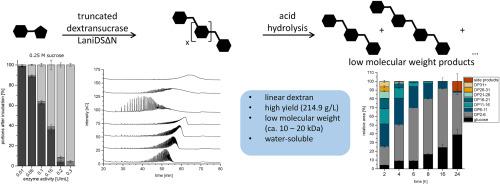利用动物乳杆菌 TMW 1.971 的截短葡聚糖酶高产生产完全线性的葡聚糖和异麦芽寡糖。
IF 2.4
3区 化学
Q3 BIOCHEMISTRY & MOLECULAR BIOLOGY
引用次数: 0
摘要
有几种乳酸菌能够利用葡聚糖琥珀酸酶从蔗糖中生产葡聚糖等水溶性外多糖。目前已描述了几种重组葡聚糖琥珀酸酶,但产量往往有限,而且大多数葡聚糖在 O3 位发生支化。在这项研究中,重组生产了来自动物舌杆菌 TMW 1.971 的葡聚糖粘多糖酶,去除了其 N 端可变区,并将其用于葡聚糖合成。与其他葡聚糖琥珀酸酶相比,该酶表达良好,显示出极高的总活性和转移酶活性。在特定条件下,它几乎能将所有葡萄糖从蔗糖转移到低聚物和聚合产物中(转移的葡萄糖约占 95%)。该酶的高效率使其能够从 1.5 M 的蔗糖溶液中获得高达 214.9 g/L 的绝对葡聚糖产量。产物的结构特征显示,生成的葡聚糖分子量相当低,粒度分布窄,且完全呈线性。此外,我们还发现通过酸水解法可以有效地生产出各种低分子量的葡聚糖或 1,6 连接的异麦芽寡糖。总之,我们证明了动物假丝酵母 TMW 1.971 葡聚糖酶可用于高效合成具有独特结构组成的葡聚糖。生产出的葡聚糖具有很大的进一步应用潜力,如合成共聚物或具有非常明确分子结构的尺寸标准。本文章由计算机程序翻译,如有差异,请以英文原文为准。

High-yield production of completely linear dextrans and isomalto-oligosaccharides by a truncated dextransucrase from Ligilactobacillus animalis TMW 1.971
Several lactic acid bacteria are capable of producing water-soluble exopolysaccharides such as dextran from sucrose by using glucansucrases. Several recombinant glucansucrases were described, however, yields were often limited and most dextrans were branched at position O3. In this study, the dextransucrase from Ligilactobacillus animalis TMW 1.971 was recombinantly produced without its N-terminal variable region and used for dextran synthesis. The enzyme expressed well and showed very high total as well as transferase activities compared to other glucansucrases. It was able to transfer nearly all glucose from sucrose to oligo- and polymeric products under certain conditions (about 95 % of glucose transferred). The high efficiency of the enzyme made it possible to obtain absolute dextran yields of up to 214.9 g/L from a 1.5 M sucrose solution. Structural characterization of the products showed that the dextrans produced have a rather low molecular weight, a narrow size distribution, and are completely linear. Furthermore, we showed that various low molecular weight dextrans or 1,6-linked isomalto-oligosaccharides can be efficiently produced by acid hydrolysis. Overall, we demonstrated that Ligilactobacillus animalis TMW 1.971 dextransucrase can be used to efficiently synthesize dextrans with a quite unique structural composition. The dextrans produced have a high potential for further applications such as synthesis of copolymers or size standards with a very defined molecular structure.
求助全文
通过发布文献求助,成功后即可免费获取论文全文。
去求助
来源期刊

Carbohydrate Research
化学-生化与分子生物学
CiteScore
5.00
自引率
3.20%
发文量
183
审稿时长
3.6 weeks
期刊介绍:
Carbohydrate Research publishes reports of original research in the following areas of carbohydrate science: action of enzymes, analytical chemistry, biochemistry (biosynthesis, degradation, structural and functional biochemistry, conformation, molecular recognition, enzyme mechanisms, carbohydrate-processing enzymes, including glycosidases and glycosyltransferases), chemical synthesis, isolation of natural products, physicochemical studies, reactions and their mechanisms, the study of structures and stereochemistry, and technological aspects.
Papers on polysaccharides should have a "molecular" component; that is a paper on new or modified polysaccharides should include structural information and characterization in addition to the usual studies of rheological properties and the like. A paper on a new, naturally occurring polysaccharide should include structural information, defining monosaccharide components and linkage sequence.
Papers devoted wholly or partly to X-ray crystallographic studies, or to computational aspects (molecular mechanics or molecular orbital calculations, simulations via molecular dynamics), will be considered if they meet certain criteria. For computational papers the requirements are that the methods used be specified in sufficient detail to permit replication of the results, and that the conclusions be shown to have relevance to experimental observations - the authors'' own data or data from the literature. Specific directions for the presentation of X-ray data are given below under Results and "discussion".
 求助内容:
求助内容: 应助结果提醒方式:
应助结果提醒方式:


